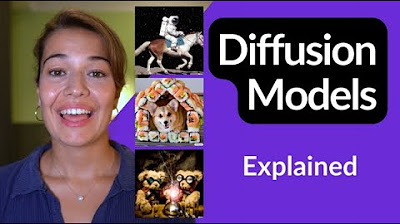How I Understand Diffusion Models
Summary
TLDRThis video script delves into diffusion models, pivotal for generating images from text, animating, and creating 3D models. It outlines the training process, emphasizing the Maximal Likelihood goal and Evidence Lower Bound (ELBO). The script explains the encoding and decoding mechanisms, highlighting the importance of the reparametrization trick. It also covers techniques for conditional generation, high-resolution image synthesis, and acceleration methods like DDIM and distillation. The script concludes with a call for questions, inviting viewer engagement.
Takeaways
- 🎨 Diffusion models are powerful generative models used for creating images, animations, videos, and 3D models from textual descriptions or by specifying conditions.
- 🧠 The core of diffusion models lies in training a denoising network that can iteratively refine noise into high-quality images, starting from a simple Gaussian distribution.
- 📈 Maximal Likelihood is the training goal, aiming to maximize the sample probability of the model, which is achieved by minimizing the Kullback–Leibler divergence between the model's output and the true data distribution.
- 🔍 The Evidence Lower Bound (ELBO) is a key concept in training, serving as a lower bound on the log-likelihood and is optimized by maximizing it during the training of diffusion models.
- 🌐 The encoding process in diffusion models is characterized by progressively adding noise over multiple steps, while the decoding process involves removing noise to generate the final output.
- 🔄 The training of diffusion models involves three main objectives: prior matching, reconstruction, and denoising matching, which ensure the model's output aligns with the Gaussian prior and reconstructs the original image accurately.
- 🔮 Three interpretations of the training process include predicting the noisy image, the noise itself, or the score (gradient of the log-likelihood), each providing different insights into the model's operation.
- 📸 For conditional generation, such as creating images of cats wearing sunglasses from a text prompt, diffusion models can be guided using either a classifier or a classifier-free approach.
- 🖼️ High-resolution image generation can be achieved through various methods like cascade models, latent diffusion models, or end-to-end models, each with its own approach to scaling up image resolution.
- ⏱️ To accelerate the sampling process and make diffusion models more practical, techniques such as DDIM, distillation, and consistency models are used to reduce the number of required denoising steps.
Q & A
What are diffusion models known for?
-Diffusion models are known for their ability to generate high-quality images from text descriptions, animate people, create videos, and produce 3D models.
What are the four main topics covered in the video regarding diffusion models?
-The four main topics covered are Training, Guidance, Resolution, and Speed.
How does a generative model translate noise samples into high-quality images?
-A generative model aims to find parameters of a decoder that can transform a simple Gaussian distribution into a complex natural image distribution.
What is the training goal in terms of data distribution?
-The training goal is to maximize the sample probability, known as Maximal Likelihood, which involves approximating the true data distribution by collecting many data samples.
How is the log-likelihood value simplified in the context of diffusion models?
-The log-likelihood value is simplified by applying a log function to turn the product into a sum, which helps rewrite it as an expectation.
What is the Evidence Lower Bound (ELBO) and why is it significant?
-ELBO is a lower bound of the log-likelihood value and is significant because it measures the statistical evidence for the model. It is used to train models like Variational Auto-Encoders (VAEs) and diffusion models by maximizing this bound.
How does the encoding process in diffusion models differ from traditional encoding?
-In diffusion models, the encoding process adds noise to the image progressively over multiple steps, rather than encoding the observation in one step like in traditional models.
What are the three terms in the objective function for training a diffusion model?
-The three terms are: 1) Prior matching, ensuring the latent distribution is similar to the Gaussian distribution at the end of diffusion steps. 2) Reconstruction, similar to the VAE's reconstruction term. 3) Denoising matching, focusing on the difference between the noisy and less noisy images.
How does the reparametrization trick help in modeling noisy images?
-The reparametrization trick allows a random variable to be expressed as a deterministic function of a noise variable, which helps in modeling noisy images by representing them as a function of a clean image and a noise variable.
What is the role of the denoising network during the training of a diffusion model?
-The denoising network models the probability of a less noisy image given a noisy image and guides the generation process by predicting the direction to maximize the log probability, which is crucial for both unconditional and conditional generation.
How can high-resolution images be generated using diffusion models?
-High-resolution images can be generated using methods like cascade models, Latent Diffusion Models (LDM), or end-to-end diffusion models, each involving different approaches to upscaling or encoding images before decoding to the desired resolution.
What are some methods to accelerate the sampling process in diffusion models?
-Acceleration methods include using Deterministic Divergence-free Interpolation (DDIM) for a deterministic generative process, distillation to reduce the number of sampling steps, and consistency models to ensure the model predicts the same origin for any point on the path.
Outlines

Этот раздел доступен только подписчикам платных тарифов. Пожалуйста, перейдите на платный тариф для доступа.
Перейти на платный тарифMindmap

Этот раздел доступен только подписчикам платных тарифов. Пожалуйста, перейдите на платный тариф для доступа.
Перейти на платный тарифKeywords

Этот раздел доступен только подписчикам платных тарифов. Пожалуйста, перейдите на платный тариф для доступа.
Перейти на платный тарифHighlights

Этот раздел доступен только подписчикам платных тарифов. Пожалуйста, перейдите на платный тариф для доступа.
Перейти на платный тарифTranscripts

Этот раздел доступен только подписчикам платных тарифов. Пожалуйста, перейдите на платный тариф для доступа.
Перейти на платный тариф5.0 / 5 (0 votes)






